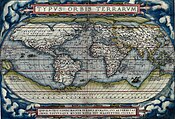
Back Geografi ACE Aardrykskunde Afrikaans Geografie ALS መልክዓ ምድር Amharic Cheografía AN भूगोल ANP جغرافيا Arabic ܓܐܘܓܪܦܝܐ ARC جغرافيا ARY جغرافيا ARZ
| Part of a series on |
| Geography |
|---|
 |
Geography (from Ancient Greek γεωγραφία geōgraphía; combining gê 'Earth' and gráphō 'write') is the study of the lands, features, inhabitants, and phenomena of Earth.[1] Geography is an all-encompassing discipline that seeks an understanding of Earth and its human and natural complexities—not merely where objects are, but also how they have changed and come to be. While geography is specific to Earth, many concepts can be applied more broadly to other celestial bodies in the field of planetary science.[2] Geography has been called "a bridge between natural science and social science disciplines."[3]
Origins of many of the concepts in geography can be traced to Greek Eratosthenes of Cyrene, who may have coined the term "geographia" (c. 276 BC – c. 195/194 BC).[4] The first recorded use of the word γεωγραφία was as the title of a book by Greek scholar Claudius Ptolemy (100 – 170 AD).[1] This work created the so called "Ptolemaic tradition" of geography, which included "Ptolemaic cartographic theory."[5] However, the concepts of geography (such as cartography) date back to the earliest attempts to understand the world spatially, with the earliest example of an attempted world map dating to the 9th century BCE in ancient Babylon.[6] The history of geography as a discipline spans cultures and millennia, being independently developed by multiple groups, and cross-pollinated by trade between these groups. The core concepts of geography consistent between all approaches are a focus on space, place, time, and scale.[7][8][9][10][11][12]
Today, geography is an extremely broad discipline with multiple approaches and modalities. There have been multiple attempts to organize the discipline, including the four traditions of geography, and into branches.[13][3][14] Techniques employed can generally be broken down into quantitative[15] and qualitative[16] approaches, with many studies taking mixed-methods approaches.[17] Common techniques include cartography, remote sensing, interviews, and surveying.
- ^ a b Dahlman, Carl; Renwick, William (2014). Introduction to Geography: People, Places & Environment (6th ed.). Pearson. ISBN 978-0137504510.
- ^ Burt, Tim (2009). Key Concepts in Geography: Scale, Resolution, Analysis, and Synthesis in Physical Geography (2nd ed.). John Wiley & Sons. pp. 85–96. ISBN 978-1-4051-9146-3.
- ^ a b Cite error: The named reference
Sala1was invoked but never defined (see the help page). - ^ Roller, Duane W. (2010). Eratosthenes' Geography. New Jersey: Princeton University Press. ISBN 9780691142678. Retrieved 29 January 2024.
- ^ Brentjes, Sonja (2009). "Cartography in Islamic Societies". International Encyclopedia of Human Geography. Elsevier. pp. 414–427. ISBN 978-0-08-044911-1. Retrieved 29 January 2024.
- ^ Kurt A. Raaflaub & Richard J. A. Talbert (2009). Geography and Ethnography: Perceptions of the World in Pre-Modern Societies. John Wiley & Sons. p. 147. ISBN 978-1-4051-9146-3.
- ^ Cite error: The named reference
Thrift1was invoked but never defined (see the help page). - ^ Cite error: The named reference
Kent1was invoked but never defined (see the help page). - ^ Cite error: The named reference
Tuan1was invoked but never defined (see the help page). - ^ Cite error: The named reference
Tuan2was invoked but never defined (see the help page). - ^ Cite error: The named reference
Castree1was invoked but never defined (see the help page). - ^ Cite error: The named reference
Gregory1was invoked but never defined (see the help page). - ^ Cite error: The named reference
Traditions1was invoked but never defined (see the help page). - ^ Cite error: The named reference
Tambassiwas invoked but never defined (see the help page). - ^ Cite error: The named reference
Fotheringham1was invoked but never defined (see the help page). - ^ Cite error: The named reference
RyanBurns1was invoked but never defined (see the help page). - ^ Diriwächter, R. & Valsiner, J. (January 2006) Qualitative Developmental Research Methods in Their Historical and Epistemological Contexts. FQS. Vol 7, No. 1, Art. 8